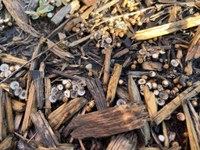Dakota Gardener: A garden fungus
(Click an image below to view a high-resolution image that can be downloaded)
By Carrie Knutson, Horticulture agent
NDSU Extension – Grand Forks County
There is truly so much beauty and wonder in nature if we take a few minutes in our busy schedules to appreciate it. I was looking at a tree last month when there was much more moisture, and something in the mulch caught my eye.
No, it wasn’t an insect, not this time anyway. It was a type of fungus called bird’s nest fungi. Bird’s nest fungi are small. You might easily step on them in the garden without noticing it. They range in size but are usually under one-quarter inch in width.
I learned about bird’s nest fungi in college. Its name and appearance have always stuck with me. The main reason is that the fungus is easily identified and appropriately named. The name matches its appearance, as it looks like a miniature bird’s nest with eggs in it.
Bird’s nest fungi are very different from the typical mushrooms in our yards. Remember, the part of the fungus that we see is the fruiting body. The nest structure of the bird’s nest fungi we see is called a peridium. It contains the “eggs,” which are specialized structures called peridioles. They contain the fungal spores. The peridioles are released and spread by water drops.
You might be wondering why I am devoting my time to discussing the beauty and wonder of a fungus. Bird’s nest fungi, other mushrooms and fungi, along with bacteria, molds and other organisms have an important function in our ecosystems. They help decompose or break down plant material. They absorb nutrients and help release them into the environment. If we didn’t have decomposers, our yards, gardens and forests would be full of plant material.
We can get flushes of mushrooms during periods of wet weather. The wet weather last fall and this spring resulted in mushrooms popping up in unexpected places. You might not have noticed their absences during the dryer years, but it is hard to miss their presence during rainy weather.
If mushrooms are unsightly to you or you have pets or small children, you can rake up the mushrooms and dispose of them. If you have mushrooms growing in mulch, use a rake to move the mulch around to increase airflow. Chemical control of mushrooms is not recommended.
Finally, a note of caution because we are discussing mushrooms. Do not eat wild mushrooms unless you can 100% positively identify them, as many mushrooms are poisonous.
Because I can’t end a discussion on fungi any other way, “Why did the carrot invite the mushroom to his picnic? Because he is a fun guy (fungi)!”
Happy gardening!
NDSU Agriculture Communication – August 23, 2024
Source: Carrie Knutson, 701-780-8229, carrie.knutson@ndsu.edu
Editor: Kelli Anderson, 701-231-6136, kelli.c.anderson@ndsu.edu




